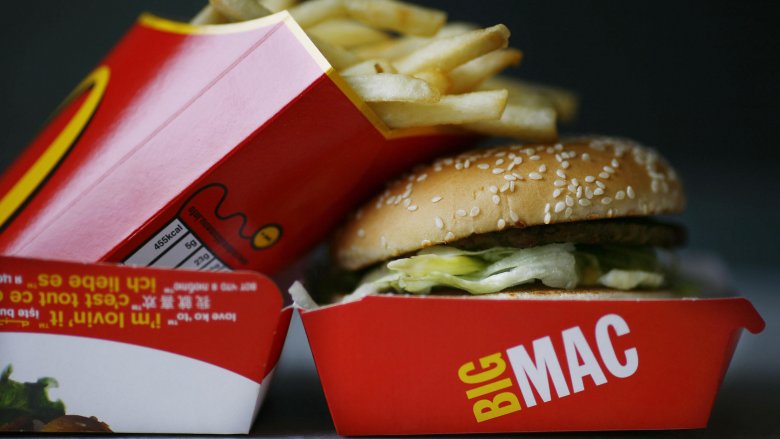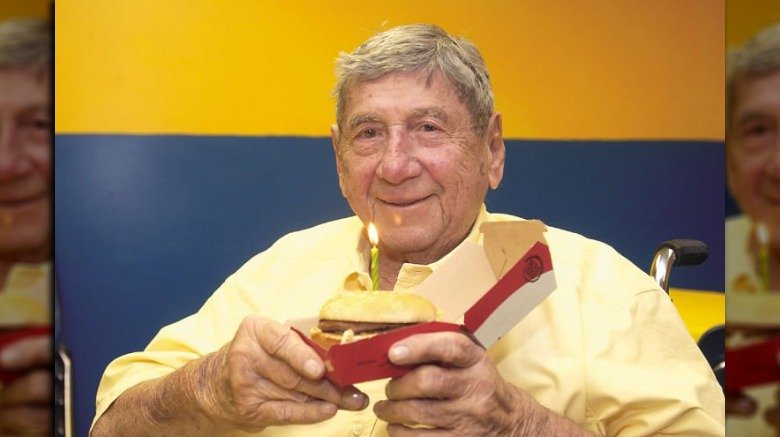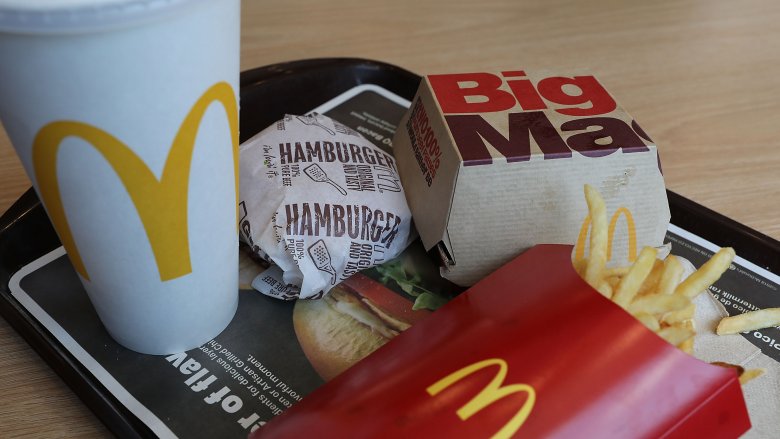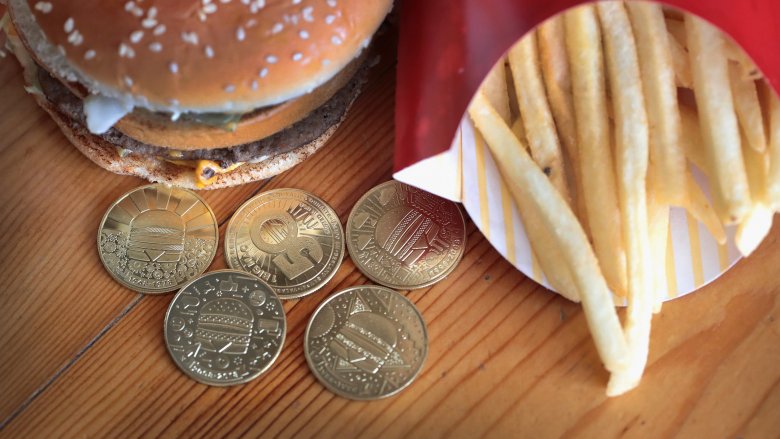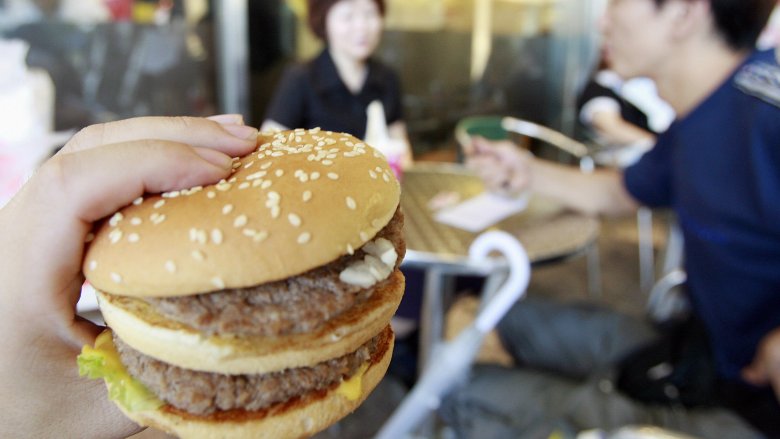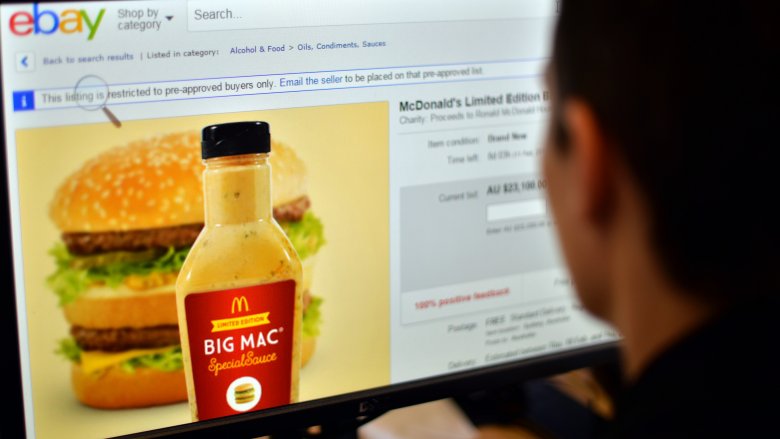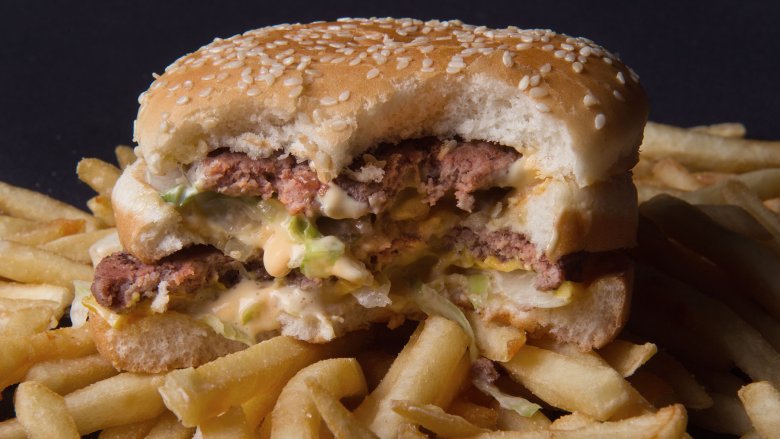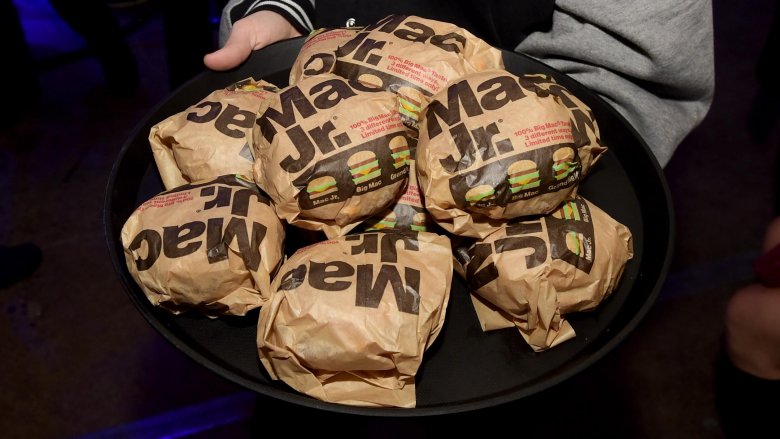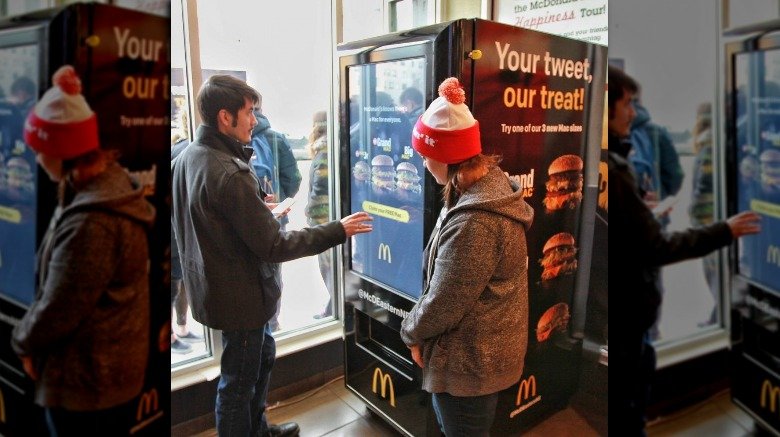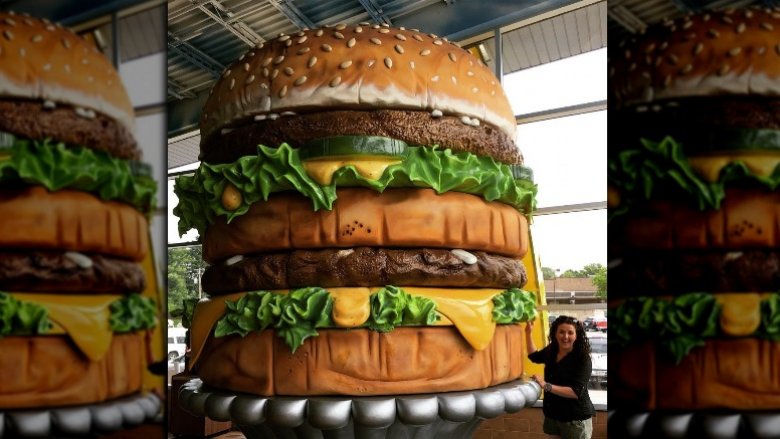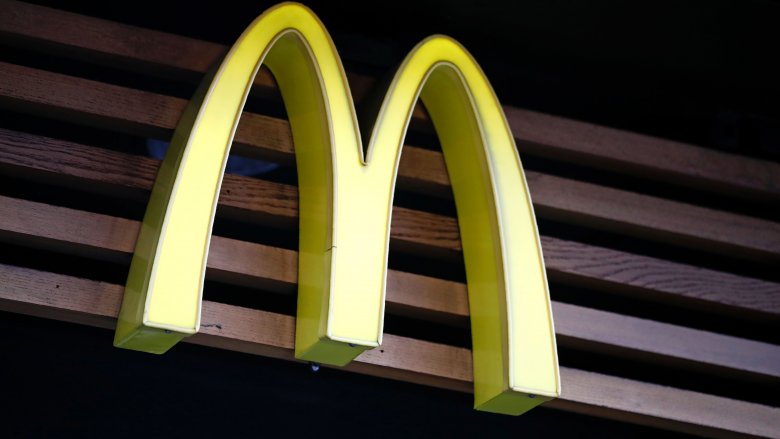What You Don't Know About McDonald's Famous Big Mac
The Big Mac is the world's most famous hamburger. Since its early creation back in the late '60s, it's gone on to make McDonald's countless billions of dollars worldwide and has become nothing short of a cultural phenomenon. Even the recipe (two all-beef patties, special sauce, lettuce, cheese, pickles, onions — on a sesame seed bun) is practically iconic.
Despite its ubiquity, however, there are plenty of aspects of the Big Mac's existence that are still little-known. In fact, beyond its name, ingredients and taste, it'd probably be fair to assume that many people don't know all that much about the Big Mac's life story. From its history, to its creator, to its impact on the world of economics, the effect it has on the human body and the world leader who can't help eating them in bed, here are a few of the more obscure facts about McDonald's flagship meal.
Its creator didn't get a big payday
The Big Mac was created by Jim Delligatti, a McDonald's franchisee, in 1967. It was intended to be a rival to Burger King's signature sandwich, the Whopper, and was to be created by Delligatti using only ingredients already available in McDonald's kitchens (except those famous sesame seed buns — he snuck those in). It was he who came up with the whole double-decker design and perfected the now-legendary special sauce. After introducing the Big Mac to his franchise, his profits soared. The burger went nationwide a year later.
While he may have enjoyed the reaping of those profits, however, the nature of the corporate system meant that it was McDonald's who made the big bucks off his invention, not Delligatti himself. According to him, while the corporation raked in the money thanks to the Big Mac's success, he was given little more than a plaque. Nevertheless, Delligatti is said to have eaten at least one Big Mac a week, right the way up until his death in late 2016.
It wasn't always the Big Mac
Although the name "Big Mac" is now pretty much inseparable from the look and taste of the McDonald's flagship burger, it wasn't always called that. When Delligatti first invented the sandwich, he named it the Aristocrat, probably in order to highlight its deluxe status on the menu. It failed to catch on with customers, however, mostly due to that inevitable whiff of elitism you're bound to get after naming a burger after a ruling social class. The Aristocrat was renamed the Blue Ribbon Burger — but this still failed to capture the hearts and minds of consumers.
Finally, in 1967, a young advertising secretary named Esther Glickstein Rose came up with the Big Mac name after being put on a spot before an important meeting, according to legend. As is to be expected in the world of '60s American advertising, her contribution was overlooked despite the name's incredible success. McDonald's wouldn't accept Rose's part in the story until 1984.
It's been around longer than you think
Having first been served nationally in 1968, the Big Mac celebrated its 50th anniversary in 2018. To celebrate, McDonald's introduced the MacCoin: a commemorative coin given out to customers who purchased a Big Mac at any one of 14,000 participating locations. In what can only be described as an incredibly misguided attempt to create a self-sustaining economy, the MacCoin could also be used to purchase another Big Mac.
Each MacCoin featured one of five different unique designs, each of which represented a decade in the Big Mac's history. The '70s coin was flower power-inspired, the '80s coin had a pop art design, the '90s coin had an abstract design, and the '00s coin showcased the technology of the era, while the '10s coin represented the decade's focus on communication. More importantly, though: as of August 2018, the entire set could be hocked on eBay for around $80, a sum definitely worth more than five Big Macs.
It has a huge economic impact
The worldwide impact of the Big Mac goes far beyond just the food industry. In 1986, The Economist introduced the Big Mac index: a universal indicator as to whether global currencies are currently sitting at their "correct" level. There's a whole lot of fancy economic theory driving the Big Mac index which has mostly to do with purchasing-power parity, which gauges the ability of exchange rates to progress so that the price of a certain product becomes the same across borders. In this case, that product is the Big Mac.
What originated as a joke has now been embraced by economists worldwide, and the Big Mac index is now accepted as a global standard and is taught to economics students in practically every country. It's a testament to the universal appeal of the Big Mac and the instant recognizability of the burger across the cultural spectrum. That or someone's not feeding the staff of The Economist well enough.
Guess who eats them in bed?
Being as widespread as it is, it should be no surprise that the Big Mac has a few famous fans. Perhaps most unsurprising of all is Donald Trump. According to journalist Michael Wolff's tell-all book Fire and Fury, the 45th President of the United States of America enjoys spending his evenings sitting in bed eating Big Macs and watching television. Wolff claims that Trump's insistence on eating from fast food joints isn't just a matter of taste, though — he also believes it lessens his chances of being poisoned.
Former Trump campaign manager Corey Lewandowski has claimed in the past that the President's regular order at McDonald's is two Big Macs, two Filet-O-Fish and a chocolate milkshake. And how does the world's most notorious politician get his Big Macs to his table (or bed)? By sending his bodyguards to get them for him, of course. That all sounds about right.
The Mac Daddy
At the time of this writing, Donald Trump is just over 72 years old. This means that, if he were to eat a Big Mac every day from the moment he was born until the point at which you're reading this article, he still wouldn't have eaten as many Big Macs as Don Gorske.
Gorske, who lives in Fond du Lac, Wisconsin, made history in 2018 by eating his 30,000th Big Mac. He himself claims that the burger represents somewhere around 90-95 percent of his overall food intake, and insists that his cholesterol and blood pressure haven't suffered for it. Since 1972, Gorske has gone only eight total days without eating a Big Mac, including one on which his local joint was shut during a snowstorm, and on the day of his mother's death. On the day he ate his 30,000th, Gorske gave a brief presentation to the small crowd who'd turned up to watch, before purchasing his 30,001st and returning home with his wife. His poor, poor wife.
The secret of the sauce
The Big Mac's special sauce is arguably as iconic as the burger itself. First developed by Jim Delligatti back in '67, the formula was fine-tuned over a couple of years before one final recipe was decided on. The recipe was altered in 1991 before reverting back to the original in 2004. Naturally, the secrecy of the sauce's recipe has made it into something of a fast food legend — and in 2016, the first ever bottle of secret sauce in the UK was auctioned on eBay by McDonald's. It sold for nearly $100,000, which the chain donated to the Ronald McDonald House charities.
The cooking website Delicious has theorized that the Big Mac sauce consists of mayonnaise, gherkin relish, white vinegar, white pepper, mustard, onion powder, garlic powder and pimenton. Regardless of how accurate that is, it's probably better for you than the real sauce, which — according to a 2017 leak — is filled with oils, colors, preservatives, emulsifiers and corn syrup (and a whopping 33 total ingredients).
What a Big Mac does to your body
Here's something that won't come as a shock: despite what a certain Wisconsin resident will likely tell you, Big Macs aren't good for you. They're actually very, very not good for you. An infographic released in 2015 detailed the exact effects the burger has on your body. Within 10 minutes, your brain releases a surge of chemicals such as dopamine, which increase your pleasure levels and generally make you feel all warm and fuzzy.
After 30 minutes, your body draws in water to attempt to balance out the sodium you've just ingested; as a result, your heart beats faster to pump blood around the body. After 40 minutes, your depleted glucose levels cause an insulin spike and give you hunger pangs, making you want more food. Full digestion of the Big Mac takes over three days, and its longest-lasting ingredient — trans fats — take around 51 days to fully digest.
When one size just wasn't enough
In 2016, McDonald's attempted to make two new additions to its menu: the Grand Mac and the Mac Jr. In an effort to replicate Burger King's own success with their resized Whopper menu items, the corporation announced that it would begin selling larger and smaller versions of the Big Mac. The Grand Mac would be made with two 1/6 lb. patties while the Mac Jr. would be made with one 1/6 lb. patty. The original Big Mac, for reference, is made with two 1/10 lb. patties.
Although McDonald's hoped the new menu items would invigorate a consumer base hungry for choice, the reviews were mixed at best. Business Insider described the Mac Jr. as "a bit underwhelming," merely "a normal single-patty cheeseburger with Big Mac sauce." Whereas the Grand Mac is "a lot to handle" and "a tad too much." Unless you've got a serious problem with the portion size of the Big Mac itself, it seems you're probably better off sticking with the original.
McDonald's got the message, and limited-time items were never added to the permanent menu.
There was a Big Mac ATM
Just like McDonald's itself, the Big Mac is often regarded as a symbol of American capitalism. And with ideas like the Big Mac ATM being bandied around, is it any wonder? It's exactly what it sounds like: an automatic burger dispenser placed on an intersection in Boston for just one day, back in 2017. While the burgers it gave out were free (it was a PR stunt, after all), the ATM would take your Twitter handle and demand permission to post from your account before giving you your burger. The tweets it sent out would pretty much advertise the Big Mac, musing on the many wonders of McDonald's and its fabulous burgers. What did you expect, though? There's no such thing as a free lunch.
Sadly, the Big Mac ATM was a one-off gimmick and hasn't been repeated since. Don't expect McDonald's to be installing these things in your local gas station anytime soon.
It has its own museum
If you've always believed that the one thing missing from the Big Mac experience is the chance to visit a museum based entirely around the sandwich — well, you're in luck. The Big Mac Museum Restaurant is located in North Huntingdon, Pennsylvania, and offers guests the chance to walk through the history of this most exalted of burgers. According to McDonald's themselves, highlights include "the world's tallest Big Mac Statue; an 18-foot electronic world map; handcrafted walnut cases filled with fascinating historic memorabilia; seven flat panel LCD display screens with vignettes about McDonald's, Jim Delligatti and Ronald McDonald House Charities; tabletops laminated with images and trivia about the triple-decker sandwich; a hands-on wall unit about RMHC; and historic graphics scattered across walls of the facility."
If you're lucky enough, you can also sit down at the restaurant's special Big Mac Booth to chow down in the company of a "life-like bronze bust of Jim Delligatti." Because who among us hasn't dreamed of eating a McDonald's burger under the cold, steely gaze of a maltreated dead man?
They might have a dark future
For over 50 years, the Big Mac has won hearts, fed stomachs,and blocked arteries across the world. But what's next for the world's most famous burger? According to The Atlantic, its future could be grim. Sales of the Big Mac were down 4.6 percent in 2014, while an internet hoax claiming McDonald's was phasing out the burger was met with a surprising willingness to accept its passing.
Of course, this is just one more thing we can blame on millennials — in 2016, McDonald's reported that only 20 percent of millennials had ever eaten a Big Mac. Everything is easier when we can blame it on the younger generation, right?
Certain reports suggest that McDonald's are considering cutting out the Quarter Pounder with Cheese, and their willingness to jump into gimmicky ventures such as the Grand Mac and Mac Jr. seem to demonstrate a certain desperation on the corporation's part. Although we're unlikely to see the Big Mac killed off entirely anytime soon, a shift in the paradigm certainly lingers somewhere on the horizon. And it's always worth remembering — nothing lasts forever.
